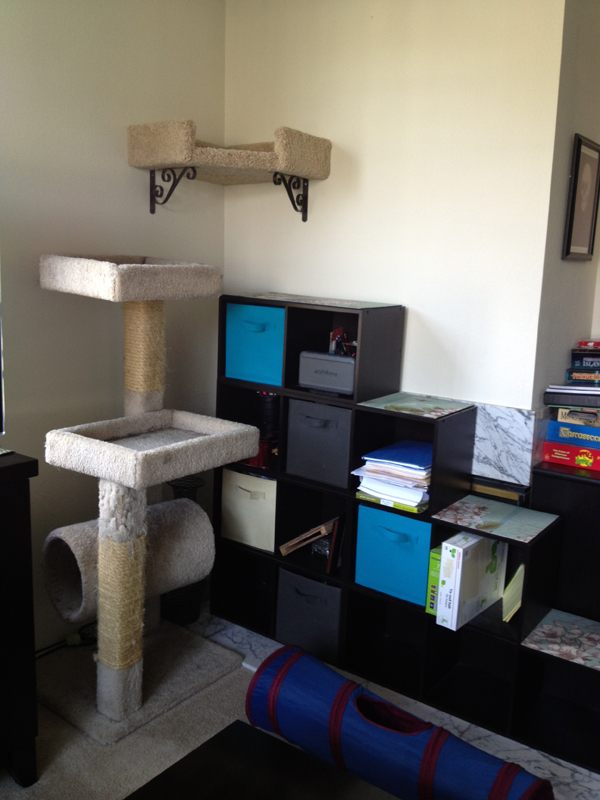Tips for Adding Vertical Territory for Cats
Let’s Get Vertical!
Cats need vertical territory. The term “vertical territory” is a catchall phrase that describes the high places cats climb and jump up too. It takes many forms—commercial and homemade. You do not have to go in debt in order to give your cats high places to hang out. You can make your own or use household furniture and architectural elements that are already built into your home. Armoires, bookshelves and the tops of entertainment centers are perfect places for cats to lounge and nap. Architectural elements such as beams and windows with wide sills can also double as vertical territory. Other solutions include readymade cat furniture such as cat trees, condos and shelves.
Vertical territory (VT) serves many functions for cats. It helps them feel safe, secure and entertained. From up high, cats can survey their world, picking out a stray morsel of food, watch the goings on in their homes and they can observe other resident animals who may pose a threat to them.
VT is one of a few ways cats show their position in their changing hierarchy. Cats are into time and room sharing. One cat might occupy the top shelf of a cat tree during the morning, another at night, while another surveys her world from up high in another room. Many factors determine where cats sit in relationship to each other. It can be as subtle as a change in room temperature, a favorite persons’ presence, the arrival of food or it may be that one cat is feeling a bit under the weather. VT helps keep the peace. For more details about why cats need VT, check out: Being High is Good. Vertical Territory Matters.
Not all vertical territory is created equal: tips for adding vertical territory
Some VT solutions are perfect—others not so much. Consider these five points when buying or building cat furniture:
- Stability. Cat furniture needs to be stable and should not have the wobbles. If it wobbles, stabilize it with extra hardware.
- Shelf size matters. Shelves and perches should be large enough to accommodate 1-2 cats. Kitties like to have the option of stretching out and lounging. Many delight in sharing a shelf with a buddy, especially on a cold day when they snuggle together for warmth.
- Check shelving surfaces. Although some creative interpretations of cat furniture are beautiful to look at, they may not be ideal for cats. Some have perches finished with a slick varnish. Cats can slip and fall when jumping up on them. Additionally, many cats find hard surfaces uncomfortable for napping. Make the slick surfaces comfortable and slip-free by firmly securing sisal, cat beds or other material to them.
- Keep it safe. Rambunctious cats can cause shelves to crash to the floor and cat trees to topple. Make them safe by securing shelves to the wall with substantial brackets and by attaching stabilizing pieces of plywood to the bases of unstable cat trees.
- Think accessibility. Cats who have special needs and those who are not quite as agile as they once were may find it difficult to navigate tall cat furniture. Help them access the tops by giving them furniture that has shelves down low they can easily reach. The lower shelves will help the special kitties safely climb to the higher perches. Pet stairs and chairs, placed next to the furniture, will also help them enjoy hanging out on cat trees and shelves.
Don’t skimp on vertical territory. More is more—your cat will thank you for it.
Follow Marilyn on Facebook
More information on how to keep cats happy is found in Marilyn's book Naughty No More!



"Stabilize it with extra hardware." How? What kind? I live in an apartment, it's not like I can drill holes or anything. This is a new problem for me -- I go for rescue cats, and the first one I had was declawed, so he stayed low and didn't climb, I didn't need any high furniture. He's gone now, and two weeks ago I got another rescue cat who is the opposite: loves to climb, lives in her cat tree. But it can tip and that's not a good thing. I need some more concrete help here.
I'm with you Karen. I have purchased a large tree and want to learn HOW to stabilize it by attaching to the wall...need a slow, step by step visual demo. Need info on what tools to buy to do this. 100% clear that it should be done, just need a how-to lesson...did you ever find anything? Will share if i do!